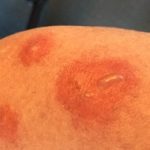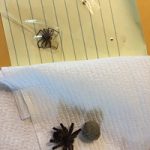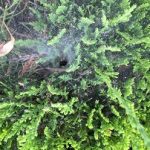Every once in a while an enormous wolf spider startles us when we go downstairs and flip on a light. We call him “Wolfie”. Fortunately, most of the time he (Wolfie might be a she) stays out of sight and is helpful because (s)he eats other critters that inhabit homes with humans.
Spiders are just about everywhere. At least 45,700 species have been identified with new ones found every year. Of all orders of living things spiders are seventh in total diversity. They live on all continents except Antarctica and in nearly every habitat except the air and salt water. Too many myths surround spiders and the stories grow around October – Halloween month. Actually, August and September in many parts of the US are prime arachnids months.
Spiders are in everyone’s home and yard. Most are tiny, harmless to humans and stay out of sight. We are most aware of spiders in the yard on mornings after a heavy dew when the lawns are carpeted with ” fairy napkins.” This is the work of funnel spiders that eat pesky insects.
All spiders share common features. Although often called “bugs” or insects spiders are arachnids that have eight legs. Insects have but six. All spiders, with possibly one exception, are carnivorous. They kill prey, which often is insects, with venom.
While we think of all spiders as predators, they themselves are an important prey species for other animals. Spot a warbler or brown creeper working its way along a tree and it’s probably seeking tiny spiders hidden in cracks in the bark or on leaves. For many birds a spider meal is simply delicious.
Spiders live in houses for good reason -food and shelter! It’s a wild world outside and plenty of insects, usually tiny and unseen, share the house with humans. They provide spiders with food. Houses are full of cracks and crevasses, perfect places for both insects and spiders to hide. Basements are usually humid, creating a perfect environment for small creatures, and when cold weather comes the furnace warms people and the insects and spiders that share the house.
Everyone has heard about Black Widow and Brown Recluse Spiders. These species can pose a health threat to people, but they are shy and rarely encountered especially in the upper Midwest.
Other spider species might also bite and inject venom. While not deadly, these bits can be uncomfortable Once after we returned from having been gone from the house for several days, Marion got nailed on her legs by a spide . She donned a pair of pants that had been hanging in a closet. Perhaps sensing a lack of activity, and finding the pants a comfy place to live, a spider had taken up residence in them. When disturbed by Marion’s putting on the pants, the spider defended itself by biting.
A doctor visit confirmed the bites. Antibiotics took care of the swelling and stinging. But, even two months later the healed over skin shows the discoloration of the bites. So, we did use spray to control any more arachnids from making themselves too comfortable in our home.
Late summer and fall are the best seasons to enjoy beautiful spider webs. At Winding Pathways, we often are graced by gorgeous intricate vertical webs strung between tall prairie grass. When dew covered in early morning, they are wondrous structures. Shelf spiders make horizontal webs, often on lawn grass, to trap insects. Our favorite, “Hawkeye” spider, really the black and yellow garden spider, weaves an orb web and makes short work of pesky garden insects. “Skinny-legged” spiders that often perch high in corners of rooms are harmless to people and keep insects that fly in open doors well at hand by trapping and eating them. Although webs are the most visible evidence of spiders many species don’t make them and rely on stealth and speed to catch prey directly.
Many people fear spiders, but they are remarkable, common and amazing animals that help keep insect numbers muted and usually don’t create problems for people.
- Arachnids around us
- This beneficial spider controls insects in the yard.





Well, I enjoyed the blog about spiders. I’m assuming that Daddy Long Legs are part of this family. To my point…I do not kill spiders. If they are in my house upstairs or down, I take a Kleenex and wrap it around the critter and deposit him outside. I know my husband thinks I’ve taken leave of my senses, but I know these critters are invaluable to my other neighbors…the birds.
Enjoy the autumn and its visitors.
Blessings, Jac
I truly love spiders. I wish everyone did.